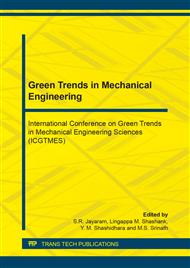p.1
p.8
p.15
p.21
p.26
p.32
p.38
p.45
p.52
Effect of Process Parameters on Cutting Forces and Surface Roughness in Machining of DSS 2205 Using Taguchi’s Approach
Abstract:
In the present study an attempt has been made to investigate the effect of process parameters on surface roughness and cutting forces generation in machining of Duplex Stainless Steel (DSS 2205) grade material with TiN coated carbide tool. Taguchi technique is used for optimizing the process parameters. L27 orthogonal array was used to conduct the experimental trials. Cutting forces recorded using piezo-electric based mill tool dynamometer and surface roughness measured using surface roughness measuring instrument. The obtained results indicated that the cutting force increases with increase in feed rate and depth of cut whereas cutting forces decreases with increase in cutting speed. Surface roughness decreases with increase in cutting speed and low feed rate. Scanning Electroscope Microscopic (SEM) images indicates the feed marks, undeformed material and patches on the machined surface. The formation of material side flow and burrs on the feed marks ridges observed at higher cutting speed, low feed rate and depth of cut. It is mainly due to the material behavior like elastic-plastic deformation of the surface layer. The material side flow causes the considerable deterioration of surface quality of the DSS 2205 steel.
Info:
Periodical:
Pages:
26-31
Citation:
Online since:
November 2019
Authors:
Price:
Сopyright:
© 2019 Trans Tech Publications Ltd. All Rights Reserved
Share:
Citation:


